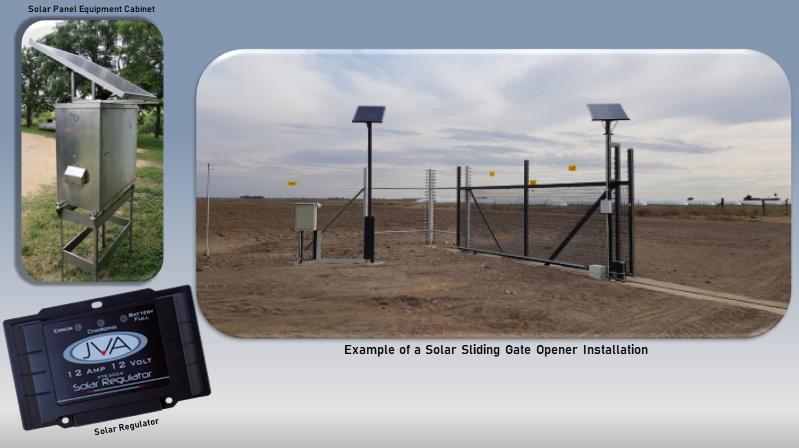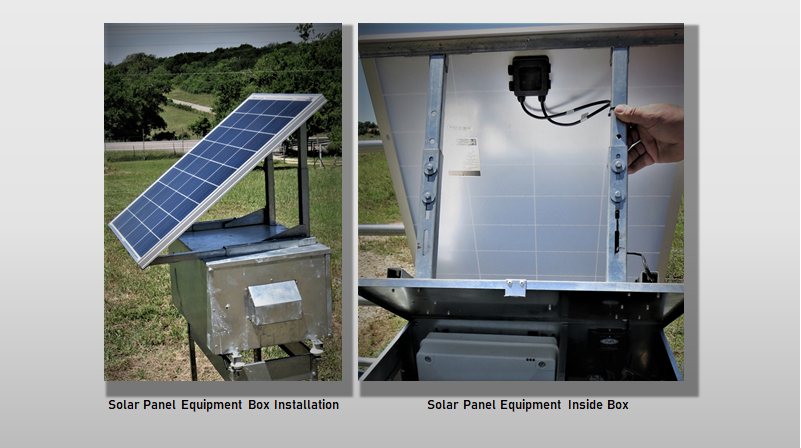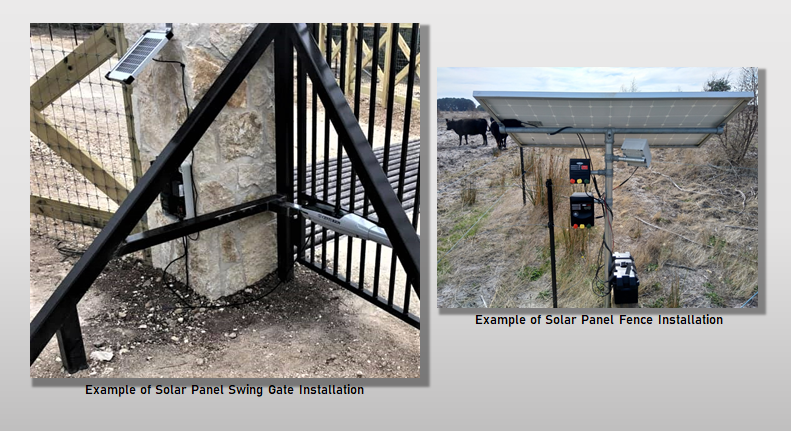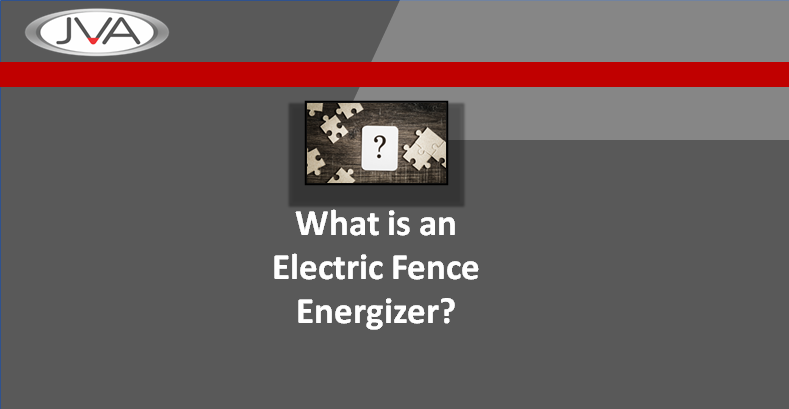In developing countries, there’s a real need for solar power because of the high frequency of power outages. In many African and South American countries, the power grid is inadequate or the grid systems fail because of a lack of, or poor, maintenance. Another issue is that the theft of copper cables to be sold for scrap metal is rife in certain areas, and the dismantling and stealing of electrical pylons cause the pylons to collapse and disrupt the power supply. Bearing all this in mind, it’s unsurprising that many people in these parts of the world choose solar power for their perimeter security setup.
In the US and other developed countries, power outages are less of a consideration. Generally, the only reason to use solar power for a gate opener is that there’s no mains power supply close by the gate. If this applies to your property, I’d advise you to look at Centurion’s solar-powered gate openers.
Solar-powered Centurion Gate Openers
Solar power systems are, as the name suggests, systems. These systems are designed to work as part of other systems that they’re supplying power to. Let’s start at the beginning by asking the question, how much power is required?
To answer this, we need to look at a few things:
- The gate opener’s power requirement
- The power requirement of the accessories that are connected to the gate opener (i.e. safety beams, keypads, free exit devices, etc.)
- Any additional systems like lights, cameras, fence energizers, or monitors
In this post, we’ll look at each of these considerations. However, if you’re not sure exactly how much power is required, don’t guess. Get a qualified installer to take a look for you, or give me a call and I can talk you through your options.
What Makes up a Solar-powered Gate System?
When designing and installing a new solar-powered gate system there’s plenty to consider. The aim is to create a cost-effective system that’s robust and reliable. It’s a fine balance to strike, and these are the key elements to consider:
Solar panels
Let’s start with the solar panels themselves. There are several factors to consider, including the size of the panel, the number of panels, the output voltage required to match the power requirement of the system, and the power consumption needing to be fed back into the battery/batteries in a given amount of time.
The number of panels will be determined by the voltage and current supply required. That will be 12-volts (V) in most instances, or a 24V system may be required when a larger gate opener is chosen for a heavy gate. In the case of a 24V system, two 12V panels would be required to charge each 12V battery.
The power rating of the panel must be considered. The panels are rated in Watts (W), and for our exercise, the power requirement can be calculated by the power required (A) multiplied by the voltage of the system (V), or W = A x V. Remember that no system is 100% efficient.
Batteries
Next, let’s look at battery requirements. This will be determined by two factors: the amount of power required in a given time period and the amount of power supplied by the solar panels. We have to remember that the solar panels only produce power while the sun is around and the light is bright enough.
Sunlight is measured in useful sunlight hours, and this will vary depending on your position on the planet, whether there is cloud cover, and the time of the year. If you’re not sure what that means for your particular location, the Internet will give you the information you need.
Type of Battery
The other factor to consider is what type of battery to use. That’s a whole other discussion that’s best saved for another time, so for now we’ll focus on lead-acid batteries as this is the most cost-effective option to complete your solar-powered system.
These batteries have a certain lifespan which is affected by a number of factors such as being left discharged for a long time, abuse – over charging or charging at a very high voltage. The battery will last for a number of cycles, that is, being charged and discharged. Assuming the battery is charged and in use, this is about 300-750 cycles on average (this will vary from manufacturer to manufacturer). What this means is that the battery dies after being charged to capacity and discharged to below the effective operating voltageof the system 300-750 times.
With this in mind, make sure the battery:
- Is large enough to supply the required power for a full day of gate operations
- Is not discharged to a very low point during that time
Regulators
The system isn’t complete yet. As solar panels vary in size and the sun varies in intensity, the battery (or batteries) need protection. This is because batteries have an optimum charge rate: if too little power is put into the battery it won’t charge, and if too much power is put into the battery it will be damaged. That’s where the regulator comes in.
To protect the battery you’ve got to fit a regulator. A regulator will prevent too much power from being forced into the battery by ensuring two things:
- That the battery is charged at the correct voltage
- That the power is throttled back when the battery is fully charged

To force more power in when the battery is fully charged or to charge the battery too quickly will result in the battery overheating. When this happens the plates inside the battery will swell and the gap between the plates will diminish. This will cause the plates to touch and an internal short circuit will occur. The affected cell will act as a bridge which will cause the output voltage to drop and you will end up having to replace the battery. This is why a regulator is a must-have when investing in a solar-powered gate motor.
What Size Components Does the System Require?
To figure this out, start by listing all the components of your solar-powered gate opener that require power. This includes the accessories that are directly coupled to the gate opener and those that aren’t, such as lights, cameras, and fence monitors.
You’ll also need to consider the following factors:
- The number of cycles per hour
- The starting power
- The running power (usually about 1/3 of the starting power)
I also advise adding a safety factor to your calculation to allow for subjectivity. What do I mean by that? Well, following the ‘bell curve’, a designer will relate to laboratory conditions, an engineer will add a safety margin, the installer never wants to go back to the installation, and a salesman will tell you what he thinks you want to hear. Every person will give a different answer, so bear this in mind when assessing your requirements.
Summary
To summarize, the solar panel has to supply power in excess of the power draw of the components in the efficient operating parameters of that panel. This is affected by the number of sunlight hours, the number of consecutive rainy or cloudy days, whether the panel will ever be cleaned, and the panel’s orientation to the sun. Always check a regulator’s current rating to ensure it can handle the output of the solar panel. And lastly, ensure that the wiring connecting everything together is thick enough to handle the current draw and to overcome the resistance of the cable if the runs are long.
As you can see, there’s a fair bit to consider when configuring a solar-powered gate opener system. Often, the best approach is to hire an installer that has experience with designing and installing solar systems. Bringing in a professional could save you a lot of wasted time and money (not to mention stress) trying to figure it out for yourself. For brave DIYers, there is a tool to assist with the task at hand.
If you’re not sure where to begin with your solar power gate opener system or you need some advice on which Centurion setup is the right one for you, give me a call day or night. You’ll always reach me, Billy, directly.
Click here to see the Centurion range.
Centurion solar power gate openers are the premium choice for motorized gate systems without the need for mains power. Not sure how to configure your solar-powered setup? Give Billy a call for some expert advice.
#AskJVABilly






